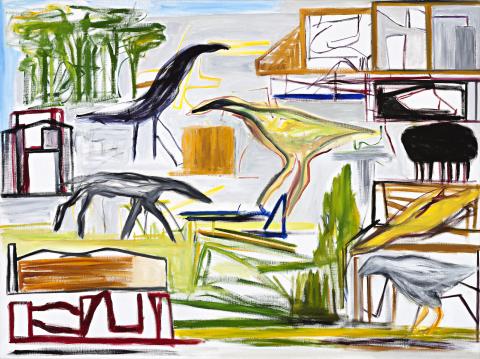FARMYARD WITH WHITE LIVORNO, 2001 – 2002
KEN WHISSON
oil on linen
90.0 x 120.0 cm
signed, dated and inscribed verso: Ken Whisson / “Farmyard with White Livorno” / Painted 21/7/01, 20/1/02 and 11/3/02 / [...]
Niagara Galleries, Melbourne
Private collection, Melbourne
Ken Whisson: New Paintings and Drawings, Niagara Galleries, Melbourne, 29 October – 23 November 2002, p. 29 (illus. in exhibition catalogue)
Ken Whisson As If, Heide Museum of Modern Art, Melbourne, 17 March – 15 July 2012; and Museum of Contemporary Art, Sydney, 28 September – 25 November 2012, cat. 158, pp. 50, 160 (illus. in exhibition catalogue)
Blue Chip XVII: The Collectors’ Exhibition, Niagara Galleries, Melbourne, 28 April – 30 May 2015, cat. 15, p. 19 (illus. in exhibition catalogue)
Ken Whisson has been exhibiting annually in Australia for decades. The consistency of his output over these exhibitions is unmatched and his often perplexing images are simply unique in Australian art. His 2012 retrospective exhibition at Sydney’s Museum of Contemporary Art and the Heide Museum of Modern Art in Melbourne was testament to the high regard in which he is held. As the artist explains, he creates his images from a standing start:
‘I just prepare a piece of canvas, a stretched canvas, white, clean. Sit down in front of it for half or three quarters of an hour till I haven’t the faintest idea of what I am going to do, and then I start painting. Sometimes with an considerable effort of will, of course. When you have a blank canvas in front of you, you have deliberately driven all thoughts and ideas out of your mind, it isn’t easy to make the first move into a painting - and sometimes the result is total chaos, sometimes semi-total chaos... but through all of this one arrives at moments (and sometimes these moments persist for several weeks)- in which everything goes right, and in which a quite complex painting, complex on every level, can be completed within a couple of hours.’ 1
Farmyard with White Livorno, 2001 – 2002 is typical of Whisson’s most characteristic works. It draws on the artist’s stored repertoire of memories and is created in his usual manner of reworking the picture over two or more painting sessions, maybe months apart, thus the various dates inscribed verso. The picture is just as likely to be a record of a conversation about a place, as much as it may be a visual depiction. The White Livorno in the title refers to the form to the lower right which is a Leghorn chicken, Livorno being the Italian name for the Leghorn.
Whisson traps pockets of the thought process and uses these to distil layers of complex visual memories into essential triggers for memory. His bright secondary colour is most important as he uses it to present the forms in a layered, matter of fact and almost simplistic manner. His basic colour combinations are not dissimilar to those of a sign writer and he uses these with similar intent, to convey ideas in a way which arrest your attention, and lead your eye through the narrative in an almost subliminal manner.
There is a profound clarity or purity about Whisson’s paintings. Apart from several early works where the influence of Danila Vassilieff and Sidney Nolan is evident, the majority are totally original paintings. The artist used his early influences as a springboard into his imagination, applied his own ideas about painting and never looked back. They are direct and uncompromised pictures in every way. Ken Whisson has lived frugally his entire life. Perhaps it is living this personal philosophy which has enabled him to create such an unparalleled and even body of work over so many decades of dedicated practice.
To own a Whisson is to belong to a club. It demonstrates a collector’s shared commitment to an art that is not simply fashionable, but deeply seeded in ideas and painterly possibilities. When you take on a Whisson, you open your mind to the purest truths and values painting can offer.
1. Murphy, B., Ken Whisson Paintings 1957-1985, The Broken Hill City Art Gallery, Broken Hill, 1985, p. 18
HENRY MULHOLLAND
